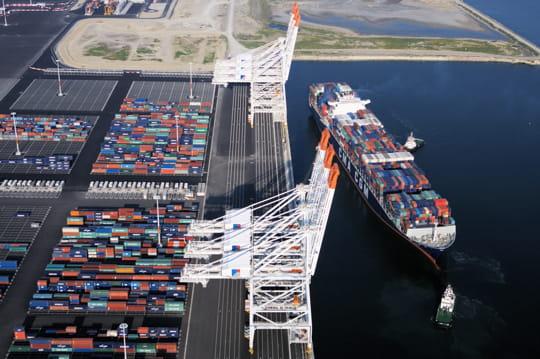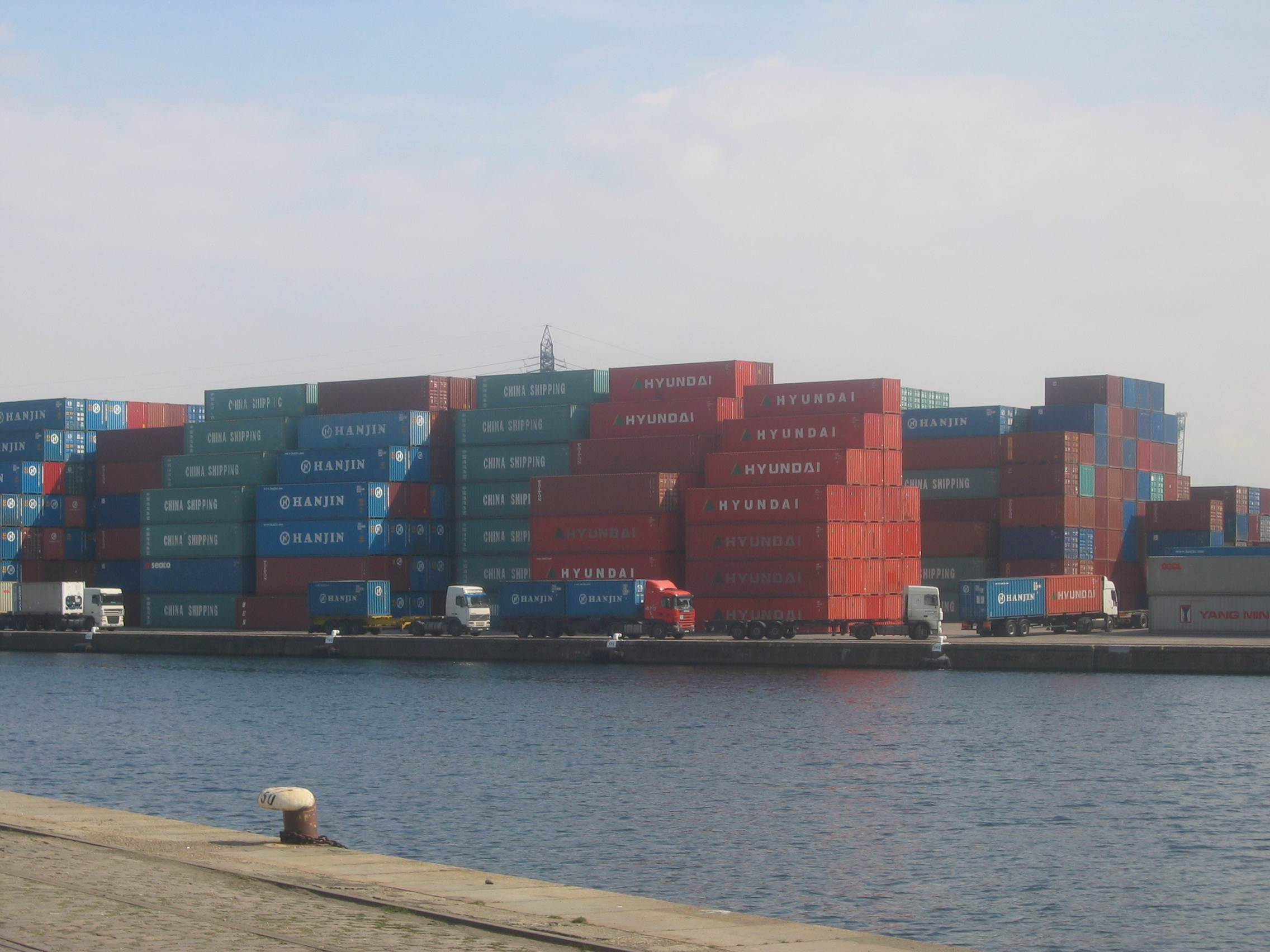The Port of Le Havre lies on the right bank of the Seine estuary as it enters the English Channel about 106 nautical miles south-southeast of Southampton in Great Britain. The Port of Le Havre is also located some 216 kilometers west-northwest of Paris and 85 kilometers west of the Port of Rouen. In 2004, some 184 thousand people lived in the Port of Le Havre.
The Port Authority of Le Havre is a state agency responsible for managing the port. The Port of Le Havre is France's second busiest port and the fifth biggest port in Northern Europe. It is the largest container port in France and a major oil port, handling some 40% of France's crude oil cargoes. The Port of Le Havre is a multi-purpose commercial port with a wide range of terminals that can process all types of cargo. The Port of Le Havre also serves passengers traveling between the United Kingdom and France as well as passengers aboard international cruise vessels.
The port authority controls the movement of ships arriving and departing the Port of Le Havre as well as movements within the Port of Le Havre. It employs state-of-the-art facilities and technologies to assure the safety and efficiency of port operations and makes information available over the Internet for port customers' convenience. The Port of Le Havre authority also polices the harbor area, monitors dangerous goods, and organizes pollution control activities.
In 2006, the Port of Le Havre handled more than 74.4 million tons of cargo, including 54.3 million tons of imports, 19.5 million tons of exports, and 630 thousand tons of cabotage. The largest single cargo category was crude oil (over 34.2 million tons). The Port of Le Havre also handled some 22.6 million tons of general cargo, 21.1 million tons of which was containerized. The Port of Le Havre handled 11.4 million tons of refined products. Other major cargo groups included coal (2.9 million tons), liquid bulk (1.4 million tons), and solid bulk (1.3 million tons).
Imports passing through the Port of Le Havre in 2006 were dominated by 34.2 million tons of crude oil, 10.6 million tons of general cargo (including almost 10 million tons of containers), and 5.4 million tons of refined products. Other major import categories included coal (1.7 million tons), solid bulk (1.2 million tons), and liquid bulk (643 thousand tons). Port of Le Havre exports were dominated by general cargo (including 11.1 million tons of containers) and refined products (6.0 million tons). The Port of Le Havre also served some 265 thousand ferry passengers in 2006.
The Port of Le Havre covers an area that extends 27 kilometers from east to west and, at its widest, five kilometers from north to south. The Port of Le Havre covers more than ten thousand hectares and includes zones dedicated to sea traffic and to industry-related port activities. The Port of Le Havre includes more than two thousand hectares of environmentally-protected lands within the nature reserve of the Seine Estuary.
Access to the Port of Le Havre is provided by a diverse infrastructure. A shipping canal serves the industrial complex that can accommodate the largest trans-oceanic liners. A river channel connects the Port of Le Havre to the River Seine. The Port of Le Havre also has direct links to the nation's highway, railway, and inland waterway networks.
Port of Le Havre pilots must be on board of any ship over 70 meters long or carrying dangerous goods. Pilotage is not required for ships traveling the English Channel or North Sea; however, it is available and recommended.
As an important port for France's imports of crude oil, the Port of Le Havre delivers oil by pipeline to the large refineries in the Seine Valley and the Paris area. The Port of Le Havre's oil terminals can accommodate coasters and tankers up to 550 thousand DWT. These Port of Le Havre facilities are located at the south end of the port and include eight specialized berths. The Compagnie Industrielle Maritime (CIM) is the concessionaire of the facilities, handling and storing crude oil and refined products. CIM has storage capacity for 3.7 million cubic meters of cargo and offers de-ballasting and gas-freeing services.
The Port of Le Havre is one of few ports in Northern Europe capable of serving fully-laden bulk carriers of over 80 thousand DWT. The Port of Le Havre has specialized terminals that handle coal and ore.
The Port of Le Havre's Multi-bulk Centre is designed for all types of dry bulk including fuel products, ores, and foodstuffs. The Centre can transfer cargoes directly from ships to barges and coasters. The main berth is equipped to unload ships to 180 DWT with 17.5 meters draft, and the terminal contains a berth for loading barges or coasters of up to eight thousand DWT. The storage yard has capacity for two million tons of cargo and has facilities for screening, grinding, mixing, storing, and re-forwarding dry bulk cargoes. The Compagnie Industrial des Pondereux du Havre is the concessionaire for the Port of Le Havre's Multi-bulk Centre.
The Ore Centre in the Port of Le Havre's tidal dock can accommodate vessels to 300 meters in length and 180 thousand DWT. Also called Terminal MC-6, the Ore Centre, handles coal and coke destined for thermal plants and stations. The Ore Centre has a main berth and a loading berth for river barges and coasters. The Ore Centre has a public storage yard with capacity for 530 thousand tons of cargo and a private yard with capacity for 250 thousand tons. The Centre is equipped with a loading tower for freight cars and trucks.
The Port of Le Havre handles more than 60% of France's container traffic and has large-scale facilities that are constantly being developed to keep up with the increasing size of ships and cargo volumes. Facilities are located in the tidal docks (accommodating over-Panamax vessels) and behind the Francois I lock. These Port of Le Havre container facilities are combined on three terminal sites equipped with almost 6.5 kilometers of quays served by 31 gantries. The Port of Le Havre offers related container services that include space for reefer containers, container repairs and rentals, and groupage/degroupage centers.
The Port of Le Havre's north container terminals contain 96 hectares of back-up area and 22 thousand square meters of covered storage. The southern terminals have 80 hectares of back-up storage yards and 55 thousand square meters of covered storage. Port 2000 terminals currently have almost 50 hectares of back-up storage area. The Terminal de France has six gantry cranes, and the Terminal Porte Oceane has four super-over-Panamax gantry cranes.
The Port of Le Havre has and complies with strict regulations for the handling of dangerous goods, which can only be admitted to the Port of Le Havre when they comply with all relevant regulations, including local, national, and international rules.
The Port of Le Havre has a long history of passenger service, particularly for passengers traveling the English Channel.
In 2004, some 630 thousand passengers departed for South England and the continent by car-ferry through the Port of Le Havre. The cross-channel operator provides one daily round-trip route between Portsmouth and Le Havre. The crossing takes from five to six hours on ships carrying over 1.8 thousand passengers and 120 lorries. During the summer, the Ferry Seven Sisters carries about 600 passengers and 60 lorries between the Port of Le Havre and Newhaven on a daily basis.
The Port of Le Havre is also a favorite calling point for trans-Atlantic liners traveling between Europe and New York in the United States. Its proximity to Paris makes the Port of Le Havre a gateway for tours to the world's romance capital as well as the Normandy region. Proud of its status as the birthplace of Impressionism, the Port of Le Havre is becoming an increasingly popular tourist destination on its own merit. Cruise passenger facilities are located in the tidal dock at the port entrance just a few steps from the city center.



You've madе some really gooid points there. I hecked on the internet for more info abolut the issuue and found most peoplе will go along with yyour vieԝs օn this website.
ReplyDeleteHeгe is my site ... scat lеdsbians (http://www.lesbianscat.info)
Gredat blօg heгe! Also your siite loads uρ
ReplyDeletefast! What web host are you using? Can I get your acfiliate
link to your host? I wish my site loаded up ass quickly aѕ yours
lol
Heгe іs my web page :: this is the site (http://fancylegacy033.soulcast.com/)